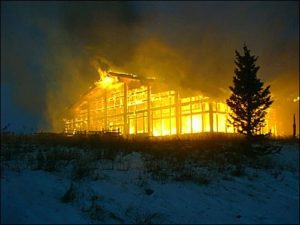VAIL, Colo. – Twenty years ago,Vail was in turmoil, trying to make sense of what had just happened.
Two Elk, the magnificent cafeteria atop Vail Mountain, had burned in the dark of night on Oct. 19. Gas cans were found nearby in the forest.
A few days later, an e-mail was sent to several media by a group that variously called itself the Earth Liberation Front and Animal Liberation Front.
“This action is just a warning,” said the e-mail. “Putting profits before Colorado’s wildlife will not be tolerated.”
 Andy Daly was then the president of the operating division of Vail Resorts responsible for Vail Mountain and the nearby Beaver Creek. In an interview with the Vail Daily, he recalled being awakened at 4 a.m. with news of the fire. In the days afterward, at a community meeting, he brought cheers with his anguished but defiant declaration: “Don’t let the bastards wear you down.”
Andy Daly was then the president of the operating division of Vail Resorts responsible for Vail Mountain and the nearby Beaver Creek. In an interview with the Vail Daily, he recalled being awakened at 4 a.m. with news of the fire. In the days afterward, at a community meeting, he brought cheers with his anguished but defiant declaration: “Don’t let the bastards wear you down.”
Lynx had been central to protests against the Forest Service authorization of the ski area expansion then called Category III. It is now known as Blue Sky Basin, and the expansion area alone was larger than many ski areas, pushing Vail Mountain to above 5,000 acres in skiable terrain.
Lynx early in the 20th century have been described as “tolerably common” in many areas of the Colorado mountains. They had been heavily trapped for their fur. One of the last known lynx had been trapped adjacent to Vail in 1973.
Beginning in early 1999, the Colorado Division of Wildlife released 218 lynx into the San Juan Mountains obtained from Canada and Alaska. That reintroduction was funded, in part, by Vail. All were fitted with telemetry collars, to enable wildlife biologists to track their movements. By the summer after the first were released, three had made their way to the Vail area. One was almost immediately squashed on Interstate 70 near Vail Pass.
Biologists now estimate that a self-sustaining population of lynx live in Colorado’s high country, with the core population in remote corners of the San Juan Mountains.
As for the arsonists, they were branded as eco-terrorists, ultimately found out, and nearly all sentenced to prison. They called themselves “The Family.” The group consisted of about 20 individuals, most from the Pacific Northwest. Between 1995 and 2001, according to the Federal Bureau of Investigation, they committed 40 criminal acts. In addition to Vail, they targeted a horticulture center at the University of Washington, a federally owned wild-horse corral in Susanville, Calif., and a horse slaughterhouse in Redmond, Ore.
The ringleader, William Rodgers, who went by the name Avalon, committed suicide while in jail. All but one have been apprehended. The most recent arrest was in August, when Joseph Mahmoud Dibee, 50, pleaded guilty to arson and conspiracy charges. He had fled the United States in 2006 but was nabbed by Cuban authorities as he prepared to fly to Russia.
Now, just one individual remains on the lam: Josephine Sunshine Overaker, who is believed to be 43 or 46 years old and living in Europe.


